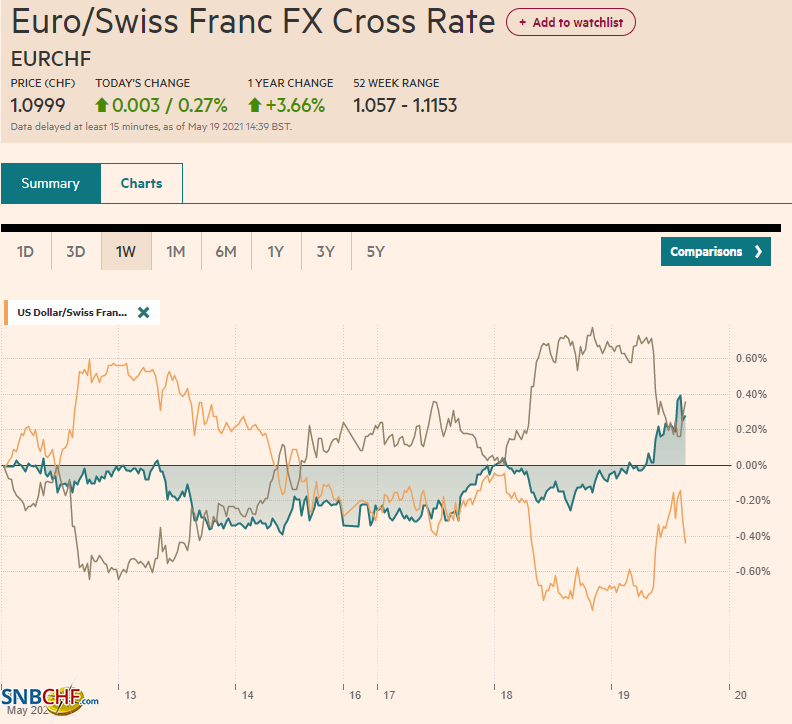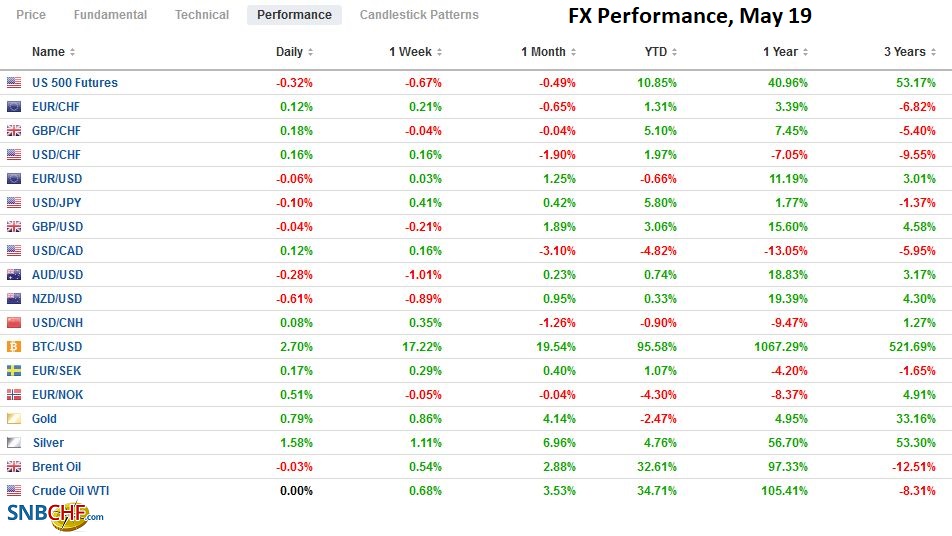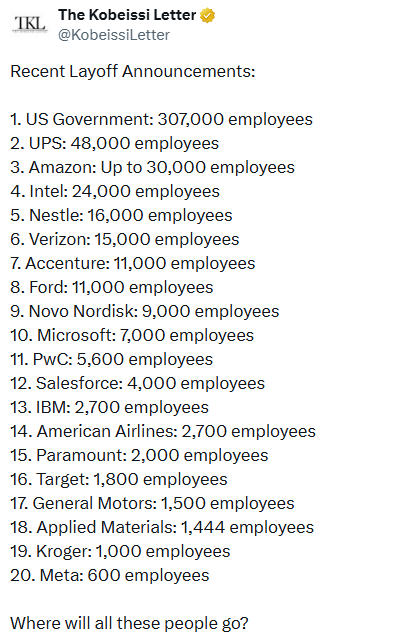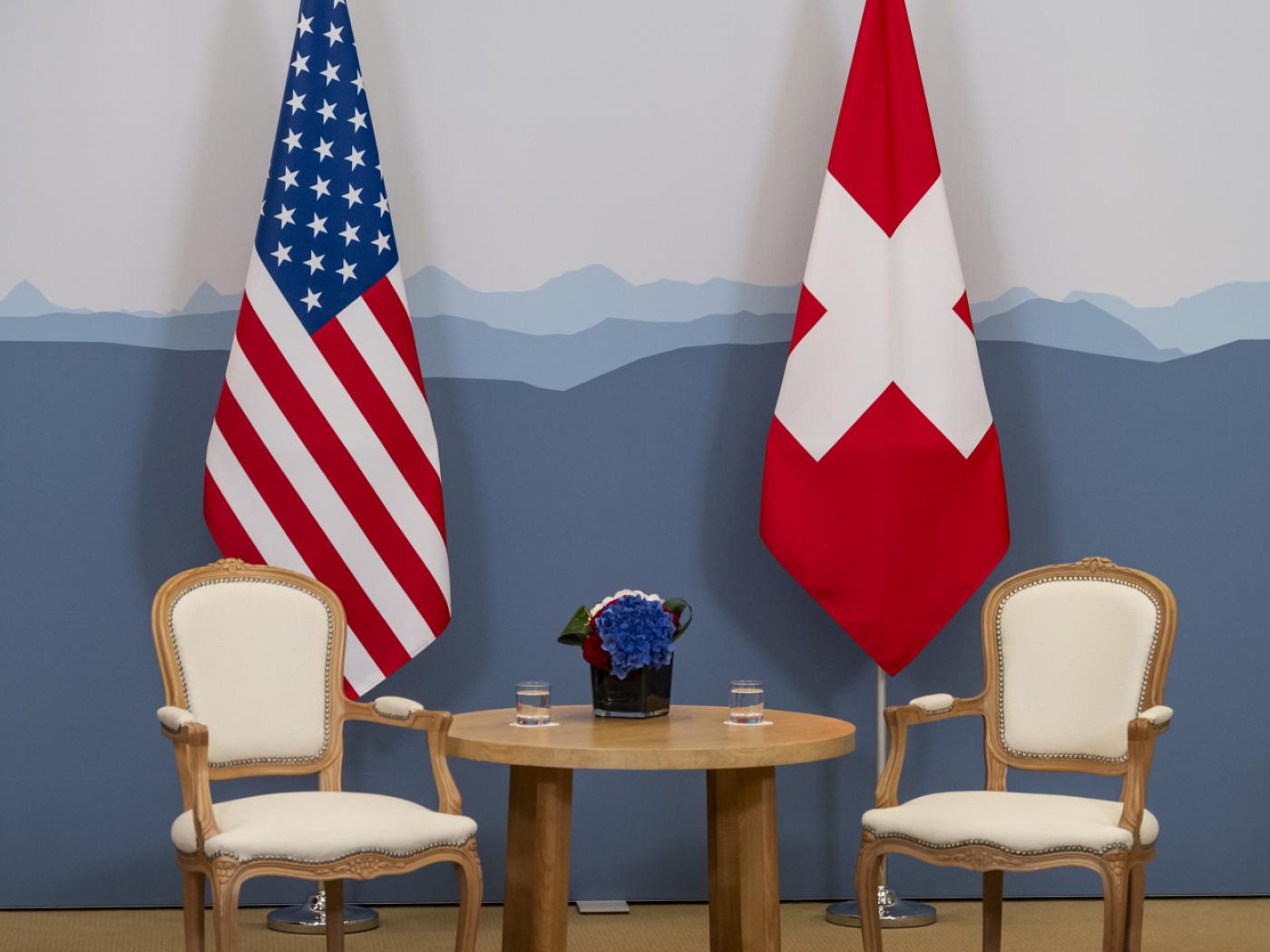Swiss FrancThe Euro has risen by 0.27% to 1.0999 |
EUR/CHF and USD/CHF, May 19(see more posts on EUR/CHF, USD/CHF, ) Source: markets.ft.com - Click to enlarge |
FX RatesOverview: A setback in commodities and technology are roiling equity markets today. The inability of US equities to sustain yesterday’s rally provided an initial headwind to trading in the Asia Pacific region today. Hong Kong and South Korea markets were closed for holidays, but most of the bourses fell, led by Australia, where the market tumbled nearly 2%, the most in almost three months as the drop in mining and energy took a toll. Europe’s Dow Jones Stoxx 600 gapped lower, and information technology, materials, and energy were the largest drags. US equity futures are seeing follow-through selling as well. Bonds are not drawing a safe-haven bid. The 10-year US Treasury yield is up a couple of basis points to 1.66%, while European yields are mostly 2-3 bp higher. The dollar is finding a bid after the downside momentum stalled in North America yesterday. The Antipodeans and Norwegian krone are the weakest. The Canadian dollar is faring the best of dollar bloc. Emerging market currencies are also mostly weaker, snapping a four-day advance in the JP Morgan Emerging Market Currency Index. Gold is backing off after reaching $1875 yesterday. It looks poised to return to the $1850 area. July WTI is near $64 after briefly poking above $67 yesterday. |
FX Performance, May 19 |
Asia Pacific
Early in the North American session yesterday, the PBOC took to its We Chat account to announce that digital currencies ought not to be used in the financial markets or real economy as money because they are not “real currencies.” The PBOC said that financial and payment companies cannot price products in any digital currency and cannot issue crypto tokens. The PBOC announcement was quickly followed by a joint statement by China’s Internet Finance Association, Banking Association, and Payments and Clearing Association. Officials did not address the mining of crypto, and China is reportedly home to as much as 70% of Bitcoin mining. Some argue that China is taking action to secure an unchallenged monopoly by the digital yuan.
There may be some merit in the claim, but it has yet to be demonstrated that crypto is being used as money. Yes, some credit card companies and non-bank financial institutions are creating the capacity to transact with crypto. Yet, the use of it to purchase goods or services remains very limited, it appears. Air miles and hotel rewards schemes appear to be used more for transactions than crypto. In addition, is the volatility. Bitcoin has lost almost 40% of its value since the April 14 high. Etherium, the second-largest in the crypto space, has fallen by about a third in the past two weeks.
Back when Bitcoin first rose above $50k, many insightful people made all kinds of extrapolations about what it meant about the world. Many claimed that it said something about Fed policy or about the role of the dollar, or even the US, in the world. Rather than see it as an international phenomenon or the result of bold innovation, it was seen as a sign of America’s decline, often a preconceived idea (confirmation bias) of the observers. A little more than 20 years ago, people argued the single currency in Europe would replace the dollar. Then it was the Chinese yuan that was going to supplant the dollar. More recently, it was crypto.
After falling for four days, the dollar has found a bid against the Japanese yen, seemingly helped by the stabilization of US rates. The exchange rate appears more sensitive to even small developments in the bond market than in equities. The greenback has been confined to a little more than 10 pips on either side of JPY109.00, where a nearly $400 mln option is struck that expires today. Resistance is seen in the JPY109.20-JPY109.30 area.
The Australian dollar buying lifted it above $0.7800 yesterday, but it is on its heels today, slipping through yesterday’s lows near $0.7760. Support is seen near $0.7730. An option at $0.7735 for about A$350 expires today, and there is one at $0.7730 that expires tomorrow. Last week’s low was close to $0.7690.
The US dollar’s bounce is working in the PBOC’s interest. Yesterday’s fix seemed to possibly suggest official resistance to yuan strength. Today’s dollar gain today is the most in a week and recoups most of the net losses over the past two sessions to be nearly flat on the week. The PBOC set the dollar’s reference rate at CNY6.4255, which in line with the bank models anticipating CNY.64251, according to Bloomberg.
Europe
UK April prices increased in line with expectations, but the BOE has made it clear that, like the Federal Reserve and the European Central Bank, it too views the price pressures as transitory. CPIH, which includes owner-equivalent costs for shelter, rose to 1.5% from 1.0% in March. The core rate more modestly to 1.3% from 1.1%. Energy prices were the main driver, with a 9% increase in gas and electricity. Clothing and footwear rose by 2.4%. Among producer prices, input prices rose 9.9%, driven by metal and mineral prices, accelerating from a revised 6.4% in March (initially 5.9%). Output prices rose by 3.9% year-over-year. The gap between input and output prices warns of a squeeze on margins if sustained. The December 2022 short-sterling futures contract is pricing in a rate hike.
Europe will reportedly formally halt the ratification process of the Comprehensive Agreement on Investment that was struck with China last year after seven years of negotiating. Recall that the EU had joined with the US and UK to sanction China over human rights abuses. China retaliated by sanctioning several European officials, including a couple of members of the European Parliament. Reports suggest Europe is demanding the lifting of the retaliatory sanctions as a pre-condition to resuming the treaty’s ratification, not the end of the human rights abuses. On a separate front, the US is signaling it may lift the sanctions on the Nordstream 2 pipeline construction company and CEO. The US is still opposed to the project, but the Biden administration has signaled that it does not want to further escalate with Germany.
Europe continues to play an important role in the negotiations to get the US and Iran back in compliance with the nuclear agreement. Some media reports played up what seemed to some as contradictory statements by the Russian envoy to Vienna, who was quoted as saying that there was significant progress and then later saying there were unresolved issues. This may have led to some gyrations in the oil market. Still, that assessment is ironically similar to what officials in the US following the meeting between the White House and Republicans over an infrastructure bill: progress was made, but not all the differences were resolved. It seems unlikely that even if the US sanctions on Iran are lifted that it would lead to a quick return of Iran’s oil fully. Some estimates suggest it could produce as much as 4 mln barrels a day. It is also believed to have around 60 mln barrels in its flotilla storage and another 20 mln barrels (roughly split between crude and condensate) in storage in China.
The euro briefly rose above the late February high to reach $1.2245 in early European turnover before sellers emerged. The is an option for nearly 500 mln euros at $1.2200 that expires today. It is finding some support just above there. A break could signal a test on the $1.2170 area, a near-term retracement target. Additional support is around $1.2150. Sterling reached $1.4220 yesterday but spent little time today above $1.4200 as the upside momentum eased. Consolidation is the main feature, and it remains within yesterday’s range. Further slippage today could see it back around $1.4130, where the five-day moving average is found.
America
There is a cynicism in Washington that is palpable. President Biden sought to justify providing Americans with a basket of goods and services that is comparable to other high-income countries with the argument that it is needed to compete with China. Yes, more than 2/3 of a century ago, war-hero and then-President Eisenhower used military considerations to argue for the National Interstate and Defense Highways Act (1954). The first Cold War confrontation (Korea) was winding down. The Senate began debating this week the Endless Frontier Act, a $100 bln five-year program to fund technology (artificial intelligence and semiconductors) to “stay ahead” of China. Despite the extreme partisanship, it was agreed the bill would go forward by an 84-11 vote. This is an example of what some of the literature refers to as military Keynesianism. In the next couple of weeks, the measures will be debated, and other bills from the Foreign Relations and Banking Committees will likely be combined with it before the legislation is sent to the House. Separately, the Biden administration is set to offer a two-week delay from the June 11 deadline for Americans to divest from several Chinese companies as it drafts news guidelines.
The fact of the matter is that American public investment in basic research and science has been MIA for many years. This is an industrial policy program under cover of defense because some apparently think that America would not support it otherwise. Moreover, it is perfectly consistent with the import-substitution strategy that began before the pandemic struck. With China being the biggest trading partner of many countries, including US allies in the Asia Pacific region, the US military commitment outstrips its relative economic stake. As the US drives to become more self-sufficient, those economic ties will weaken further. Once the US military and companies are no longer reliant on semiconductor chips from Taiwan, would its strategic significance be downgraded? Meanwhile, news this week points to China seeking to join the Comprehensive and Progressive Agreement for Trans-Pacific Partnership. You may remember it as TPP that was the strategic element of the Obama Administration’s Asian pivot. In a notable reversal. Although China’s ascension is not imminent, in a few years, it is possible that China joins and the US, of course, remains outside. China-led Regional Comprehensive Economic Partnership already includes most of the CPTPP, except Chile, Peru, Mexico, and Canada.
The FOMC minutes for last month’s meeting may draw some attention today. However, they may be more be dated than usual given the dramatic disappointment of the jobs report and retail sales. Despite the Fed’s efforts to maximize its flexibility, the challenge now is not that the market does not understand the Fed. It is that it questions it. The December 2022 Eurodollar futures continue to suggest a rate hike more than a year earlier than the Fed signals has been discounted. Canada reports April CPI figures today. The headline rate is expected to rise from 2.2% to 3.1%. The underlying measures are considerably more stable, and the median and trimmed core rates are likely little changed and holding above 2%. Although Mexico’s economic calendar is light, comments by the central bank’s Deputy Governor Espinosa confirmed what the market has suspected, and that is that the easing cycle is over. The market does appear to be pricing in a hike by the end of the year.
The US dollar held key support near CAD1.20 yesterday and recorded a six-year low. It recovered today to almost CAD1.2100. The week’s high was set so far on Monday around CAD1.2135 and is the next corrective target. Above there, a CAD1.2200 beckons. It has not closed above there in nearly two weeks. The greenback is also recovering against the Mexican peso after recording a new four-month low yesterday just below MXN19.72. The dollar approached Monday’s high of almost MXN19.95. A band of resistance is seen in the MXN19.96-MXN20.03 band.
Graphs and additional information on Swiss Franc by the snbchf team.
Full story here Are you the author? Previous post See more for Next postTags: #USD,China,crypto,Currency Movement,EU,EUR/CHF,Featured,inflation,newsletter,OIL,USD/CHF































